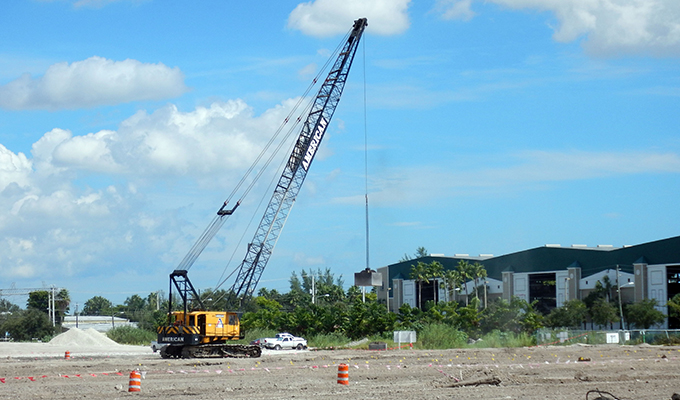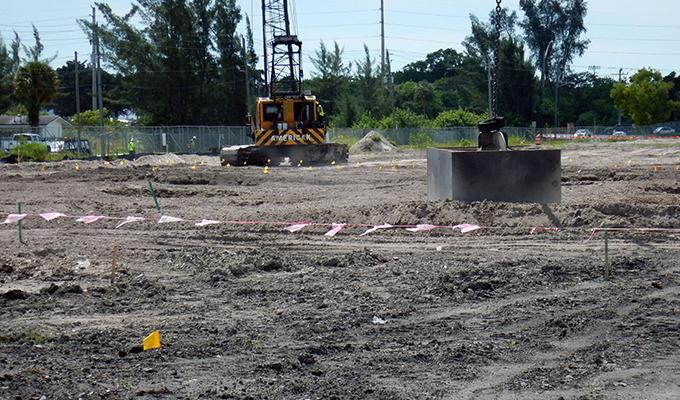By Tim Floyd
When you see Dania Pointe today, it’s hard to imagine it started out as former industrial and partially abandoned mass of land. Hoar Construction’s challenge was to help bring the client’s vision to life by transforming the complex and contaminated site into a blank canvas that could support 1 million square feet of retail, restaurants, office, hotels, apartments, and public event space.
There is a lot of work that must be done on any construction site long before vertical construction begins, and sitework is one of the most commonly underestimated phases of construction, for both budget and schedule. Hoar’s first step was to identify Danie Pointe’s many site challenges and develop a plan to overcome those. Through planning every stage of work closely with its client, engineer, and trade partners, and by collaborating closely with local municipalities, Hoar wad able to successfully transform the barren brownfield site to the massive 102-acre, mixed-use development set to become Broward County’s preeminent lifestyle destination.
STARTING FROM SCRATCH
To understand why the property in Broward County posed so many problems, it’s important to first understand its existing conditions at the time of purchase. The site consisted of multiple parcels of land, assembled by client, Kimco Realty, to be the future home of a shopping and entertainment destination. Part of the site was an abandoned brick and mortar factory. There were several existing manufacturing structures on site, sitting idle and rusting into the ground. A gas station on the property had seeped contaminants into the surrounding soil. Part of the site was home to a tree farm and an abandoned amusement park.
In addition to the geotechnical engineering survey, ownership had a hydrologist test the site further to determine the severity of the soil conditions. Combined reports showed multiple borrow pits on site that had been backfilled with trash and organic materials which created bridged areas of soil underneath. Fortunately, the client was aware of the extensive sitework requirements and brought Hoar, their engineer, and design team in early to collaborate, plan, and manage the work. The combined team was able to address issues and the work required to resolve them as Hoar planned the work and developed the budget, which helped manage costs.

A CLEAN SLATE
Once Hoar Construction knew what was going on underground, demolishing the existing structures were started. In fact, part of the demolition included tearing down a rotting wooden roller coaster, once iconic to the area. From there, Hoar led the complicated process of performing widespread remediation of the soil according to EPA-recommended methods. Once the remedial work was done, not only was the soil clean but the client saved in environmental tax credits.
The next step was locating and fixing the deep ponds and pits throughout the site. Hoar worked with the client and the civil engineer, Kimley-Horn, to perform deep dynamic compaction (DDC) for more than 40 acres. To put that in perspective, the area covered was the same as 20 city blocks. For the DDC process, a Liebherr 855 crawler crane was used to raise and drop weighted 15-ton blocks onto the ground, where the geotechnical report identified areas as potentially unstable. The compaction insures proper support of building foundations. Roughly 500,000 cubic yards of unsuitable material were removed from the Dania Pointe site before it was graded.
UNUSUAL UTILITY CHALLENGES
The extensive sitework included resolving other issues that lay deep below the ground. Approximately 2,000 linear feet of 72-inch diameter FDOT storm drainage that ran right through the middle of the site had to be rerouted. Due to depth of pipe and high-water tables, divers were utilized during the installation process. Gas, cable, and electrical lines that feed the surrounding neighborhoods, as well as fiberoptic communication lines that feed the Fort Lauderdale International airport also ran through the site. Hoar’s team successfully rerouted these lines without any negative impact through extensive planning with all of its trade partners involved.
To reroute all the utilities and lines that ran through the site, Hoar had to directional drill around the surrounding area—which is one of the busiest and most highly traveled areas in Florida. The project team bored near and underneath interstates, federal highways, and busy intersections, and also drilled underneath one of south Florida’s busiest railroads and a canal. The key to the successful completion of these installations and reroutes was developing detailed logistics plans to ensure the work was completed safely with minimal impact to traffic.
By starting the drilling in a green area and increasing the use of the directional bore in some areas by up to 800 to 1,000 feet at a time, Hoar was able to reduce the project time by 5 months and shrink its overall footprint while saving an estimated $1.5 million dollars.
INFRASTRUCTURE IMPROVEMENTS
The client’s plans included extensive infrastructure improvements to the site to account for the increase in traffic their new development will bring to the area. Fourteen thousand linear feet of sewer pipe was installed which will be available for other redevelopments to tap into in the future. In addition, Hoar enhanced the surrounding road infrastructure—working closely with multiple municipalities and government agencies. Lanes were added to the roads leading in and out of the development, including the addition of multiple signaled intersections. Transition lanes were built to I-95 from the development’s main road to accommodate increased capacity. For Broward County alone, nearly a mile of road was rebuilt wider to support the increase in traffic.
The project at Dania Pointe also provided ample opportunity to reuse and recycle. When widening the road, Hoar discovered that 80 percent of the soil underneath was poor and unsuitable for supporting the numbers of cars that would be driving there. After reviewing various options, Hoar decided to crush demolished concrete from the road and site to reuse as backfill to bridge over the unsuitable areas, which county engineers reviewed and tested material to ensure it was structurally sound.
CLOSING THOUGHT
The success story of the extensive sitework at Dania Pointe comes down to logistics. Hoar’s project team deftly developed and managed multiple complicated plans involving rerouting critical utilities and coordinating traffic through some of Florida’s busiest intersections. Hoar was able to communicate and coordinate with all the municipalities and stake holders involved to perform all the required sitework without any incidents, loss of utilities, or negative impact to the surrounding communities.
about the author:
Tim Floyd is a senior superintendent with Hoar Construction’s Florida Division. He has 25 years of industry experience, and oversees a variety of project types including mixed-use, retail, hospitality, and office. He can be reached at tfloyd@hoard.com or www.hoar.com.
Modern Contractor Solutions, March 2020
Did you enjoy this article?
Subscribe to the FREE Digital Edition of Modern Contractor Solutions magazine.



